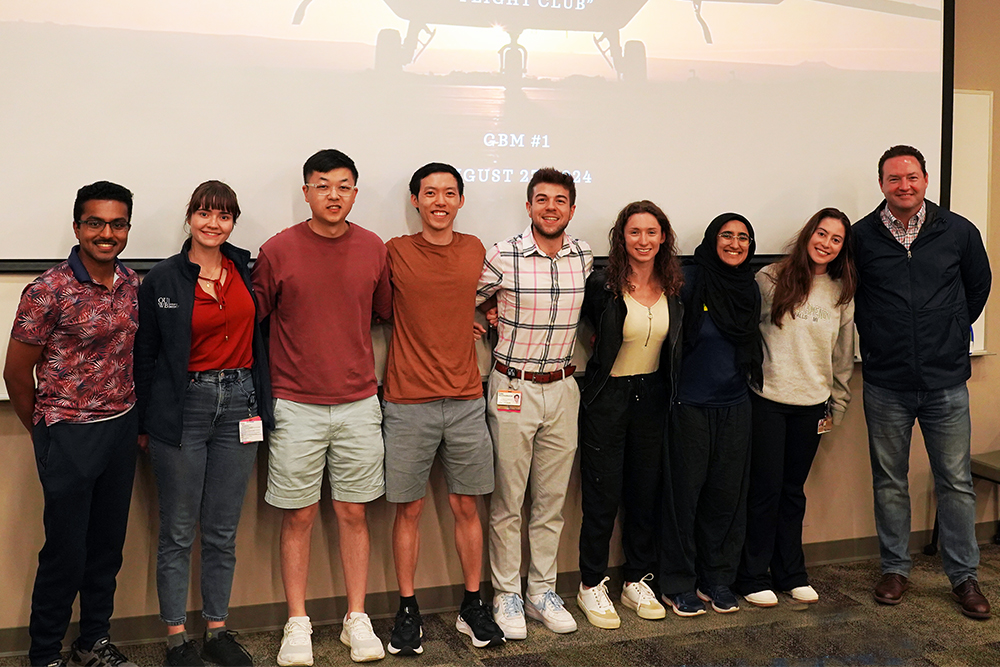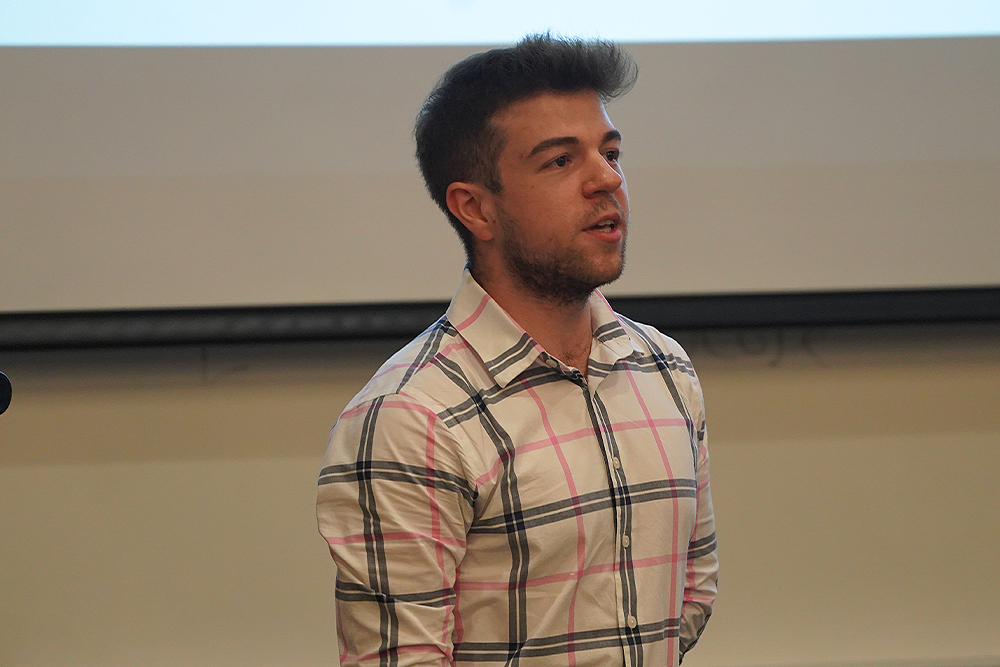A new OUWB student organization has drawn inspiration from infinity and beyond to offer new opportunities for those interested in aerospace medicine.
The OUWB Aerospace Medicine Interest Group (aka Flight Club) aims to encourage students to consider working with governmental organizations like NASA and the FAA, as well as non-governmental organizations such as SpaceX and Blue Origin.
The new organization recently held its introductory meeting that included speakers with extensive experience in the field: a current flight surgeon from NASA, and the division director for aerospace medicine at the University of Texas Medical Branch.
The OUWB medical student behind the launch of the student organization is Tyler Hershenhouse, M2 — and his ambitions for the group are as high as the moon.
“We want to make OUWB more of an aerospace medicine-centric school and get us on the map,” he said. “We are going to progress in this field and make a difference, not just in the local community but also nationally.”
Officially, Flight Club at OUWB began in May. Already, it has more than 30 members.
In July, it was approved as an affiliate of the Aerospace Medicine Student and Resident Organization (AMSRO), the official student and resident organization of the Aerospace Medical Association (AMA).
Hershehouse speaks during the introductory meeting for OUWB's Flight Club. |
According to its website, AMSRO “is a growing group of upcoming professionals in the related fields of aerospace medicine that disseminates information regarding career and educational opportunities to its membership. AMSRO provides a forum for the unification of undergraduate students, graduate students, professional students, and medical residents interested in aerospace-related fields and for the exchange of insights regarding training programs, research opportunities, and general career development.”
With acceptance into AMSRO, OUWB joins only 16 other schools that have student organizations dedicated to aerospace medicine. Membership allows OUWB medical students opportunities to engage in research, apply for scholarships, attend national conferences, and seek leadership from those in the field of aerospace medicine.
At its Aug. 27 introductory meeting for the new academic year, Flight Club members and guests primarily addressed two key questions: What is aerospace medicine and what kind of opportunities does the field afford?
First, it became a board-certified specialty in 1950.
As the name suggests, there are opportunities for physicians to work in programs related to space. For example, a physician could work for NASA and be part of the Aerospace Medicine Board, Flight Med Clinic, Neutral Buoyancy Lab, a flight surgeon and more.
Aerospace medicine also can apply to what most think of as traditional air travel (i.e. commercial airlines, military pilots, etc.).
“You’re really the team doctor for people who fly for an occupation,” said Natacha Chough, M.D., a flight surgeon at NASA, who was one of the speakers at the first meeting of OUWB’s Flight Club.
“I want to be clear that a flight surgeon doesn’t fly in space,” she added. “The bulk of what we do is supporting folks to make sure they’re medically safe and stable enough to do this flying occupation for a living without having sudden incapacitating medical issues or problems that may interfere with their duties in the high performance, technical occupation.”
She called it a “super amazing job.”
“You may see us at launches and landings, but that’s only a very small timeframe of what actually is a huge spectrum of care,” he said. “We’re all over in terms of where and how we provide support.”
Ronak Shah, D.O., associate professor and director, Aerospace Medicine, UTMB Health, was the other speaker during the meeting.
He explained while some may believe there’s a need to separate training for space travel and aviation, there is “tremendous overlap.”
“Both deal with altered pressure environments, altered gas environments, altered G environments, radiation, noise, thermal, acoustics, vibration…the list goes on,” he explained.
He also provided insight into an aerospace medicine residency at UTMB. (Completed after a previous residency in a specialty such as internal medicine or emergency medicine.)
During the two-year program, training is focused on understanding the spectrum of care warranted by an aerospace medicine specialist, such as prevention, acute care, and maintenance of primary specialty skills. Residents are also exposed to medical operations, aeromedical certification, research, and systems engineering custom-designed for non-engineers. Training is led by experienced, board-certified aerospace medicine faculty, as well as national and international experts, with specific expertise in the unique aspects of what is being taught.
But to get to that point is a long road, and that’s exactly why Hershenhouse said he wants OUWB medical students to get exposure to the field as soon as possible.
In addition to the benefits of being part of AMSRO, he expects the group to partner with other student organizations on various service-related opportunities and training. He also plans to have the OUWB Flight Club team up on projects with similar groups at other medical schools. A skills night also is in the works.
“I have no doubt that this club will continue to have many members,” said Hershenhouse. “For many (medical students), there’s a natural gravitation towards space, NASA, and aerospace medicine in general.”
Hershenhouse is among those who feel that “natural gravitation.”
“I’ve really enjoyed combining a passion for interventional cardiology and aerospace medicine,” he said. “Space has always been something that’s fascinated me growing up and I’ve never been able to let go of that childhood dream of wanting to work for an organization like NASA or SpaceX.”
For more information on Flight Club, email Hershenhouse at [email protected].
To request an interview, visit the OUWB Communications & Marketing webpage.
This work is licensed under a Creative Commons Attribution-NonCommercial 4.0 International License.



